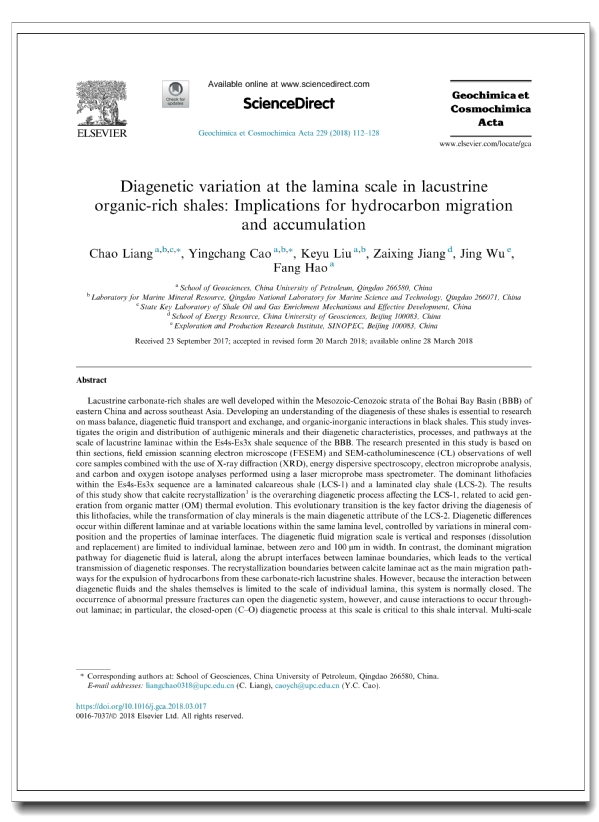Chao Liang, Yingchang Cao, Keyu Liu, Zaixing Jiang, Jing Wu, Fang Hao
Diagenetic variation at the lamina scale in lacustrine organic-rich shales: Implications for hydrocarbon migration and accumulation
Geochimica et Cosmochimica Acta,
Volume 229, 2018, Pages 112-128, ISSN 0016-7037,
https://doi.org/10.1016/j.gca.2018.03.017.
Abstract: Lacustrine carbonate-rich shales are well developed within the Mesozoic-Cenozoic strata of the Bohai Bay Basin (BBB) of eastern China and across southeast Asia. Developing an understanding of the diagenesis of these shales is essential to research on mass balance, diagenetic fluid transport and exchange, and organic-inorganic interactions in black shales. This study investigates the origin and distribution of authigenic minerals and their diagenetic characteristics, processes, and pathways at the scale of lacustrine laminae within the Es4s-Es3x shale sequence of the BBB. The research presented in this study is based on thin sections, field emission scanning electron microscope (FESEM) and SEM-catholuminescence (CL) observations of well core samples combined with the use of X-ray diffraction (XRD), energy dispersive spectroscopy, electron microprobe analysis, and carbon and oxygen isotope analyses performed using a laser microprobe mass spectrometer. The dominant lithofacies within the Es4s-Es3x sequence are a laminated calcareous shale (LCS-1) and a laminated clay shale (LCS-2). The results of this study show that calcite recrystallization1 is the overarching diagenetic process affecting the LCS-1, related to acid generation from organic matter (OM) thermal evolution. This evolutionary transition is the key factor driving the diagenesis of this lithofacies, while the transformation of clay minerals is the main diagenetic attribute of the LCS-2. Diagenetic differences occur within different laminae and at variable locations within the same lamina level, controlled by variations in mineral composition and the properties of laminae interfaces. The diagenetic fluid migration scale is vertical and responses (dissolution and replacement) are limited to individual laminae, between zero and 100 μm in width. In contrast, the dominant migration pathway for diagenetic fluid is lateral, along the abrupt interfaces between laminae boundaries, which leads to the vertical transmission of diagenetic responses. The recrystallization boundaries between calcite laminae act as the main migration pathways for the expulsion of hydrocarbons from these carbonate-rich lacustrine shales. However, because the interaction between diagenetic fluids and the shales themselves is limited to the scale of individual lamina, this system is normally closed. The occurrence of abnormal pressure fractures can open the diagenetic system, however, and cause interactions to occur throughout laminae; in particular, the closed-open (C–O) diagenetic process at this scale is critical to this shale interval. Multi-scale C–O systems are ubiquitous and episodic ranging from the scale of laminae to the whole basin. Observations show that such small-scale systems are often superimposed onto larger ones to constitute the complex diagenetic system seen within the BBB combining fluid transport, material and energy exchange, and solid-liquid and organic-inorganic interactions.


